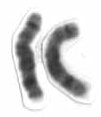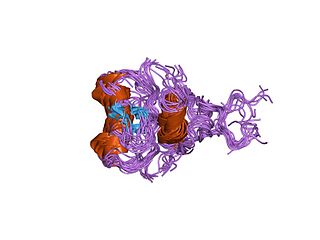
A zinc finger is a small protein structural motif that is characterized by the coordination of one or more zinc ions (Zn2+) which stabilizes the fold. It was originally coined to describe the finger-like appearance of a hypothesized structure from the African clawed frog (Xenopus laevis) transcription factor IIIA. However, it has been found to encompass a wide variety of differing protein structures in eukaryotic cells. Xenopus laevis TFIIIA was originally demonstrated to contain zinc and require the metal for function in 1983, the first such reported zinc requirement for a gene regulatory protein followed soon thereafter by the Krüppel factor in Drosophila. It often appears as a metal-binding domain in multi-domain proteins.

EGR-1 also known as ZNF268 or NGFI-A is a protein that in humans is encoded by the EGR1 gene.

Chromosome 8 is one of the 23 pairs of chromosomes in humans. People normally have two copies of this chromosome. Chromosome 8 spans about 146 million base pairs and represents between 4.5 and 5.0% of the total DNA in cells.

Zinc finger protein 638 is a protein that in humans is encoded by the ZNF638 gene.

Zinc finger protein 74 is a protein that in humans is encoded by the ZNF74 gene. Schizophrenia susceptibility has been associated with a mutation in this protein.

Zinc finger protein 202 is a transcription factor first associated with breast cancer. It is a protein that, in humans, is encoded by the ZNF202 gene.

Zinc finger protein 655 is a protein that in humans is encoded by the ZNF655 gene.

Zinc finger protein 238 is a zinc finger containing transcription factor that in humans is encoded by the ZNF238 gene.

Zinc finger protein 384 is a protein that in humans is encoded by the ZNF384 gene.

Zinc finger protein 423 is a protein that in humans is encoded by the ZNF423 gene.

Zinc finger protein 280D, also known as Suppressor Of Hairy Wing Homolog 4, SUWH4, Zinc Finger Protein 634, ZNF634, or KIAA1584, is a protein that in humans is encoded by the ZNF280D gene located on chromosome 15q21.3.

Neuregulin 3, also known as NRG3, is a neural-enriched member of the neuregulin protein family which in humans is encoded by the NRG3 gene. The NRGs are a group of signaling proteins part of the superfamily of epidermal growth factor, EGF like polypeptide growth factor. These groups of proteins possess an 'EGF-like domain' that consists of six cysteine residues and three disulfide bridges predicted by the consensus sequence of the cysteine residues.

Zinc finger protein 57 homolog (ZFP57), also known as zinc finger protein 698 (ZNF698), is a protein that in humans is encoded by the ZFP57 gene.

Zinc finger protein 184, also known as ZNF184, is a protein that in humans is encoded by the ZNF184 gene on chromosome 6. It was first identified by Goldwurm et al. in 1996.

In molecular biology, GATA zinc fingers are zinc-containing domains found in a number of transcription factors. Some members of this class of zinc fingers specifically bind the DNA sequence (A/T)GATA(A/G) in the regulatory regions of genes., giving rise to the name of the domain. In these domains, a single zinc ion is coordinated by 4 cysteine residues. NMR studies have shown the core of the Znf to comprise 2 irregular anti-parallel beta-sheets and an alpha-helix, followed by a long loop to the C-terminal end of the finger. The N-terminal part, which includes the helix, is similar in structure, but not sequence, to the N-terminal zinc module of the glucocorticoid receptor DNA-binding domain. The helix and the loop connecting the 2 beta-sheets interact with the major groove of the DNA, while the C-terminal tail wraps around into the minor groove. Interactions between the Znf and DNA are mainly hydrophobic, explaining the preponderance of thymines in the binding site; a large number of interactions with the phosphate backbone have also been observed. Two GATA zinc fingers are found in GATA-family transcription factors. However, there are several proteins that only contain a single copy of the domain. It is also worth noting that many GATA-type Znfs have not been experimentally demonstrated to be DNA-binding domains. Furthermore, several GATA-type Znfs have been demonstrated to act as protein-recognition domains. For example, the N-terminal Znf of GATA1 binds specifically to a zinc finger from the transcriptional coregulator FOG1 (ZFPM1).

FEZ family zinc finger 1 is a protein that in humans is encoded by the FEZF1 gene.

Zinc finger protein 226 is a protein that in humans is encoded by the ZNF226 gene.

Zinc Finger Protein 821, also known as ZNF821, is a protein encoded by the ZNF821 gene. This gene is located on the 16th chromosome and is expressed highly in the testes, moderately expressed in the brain and low expression in 23 other tissues. The protein encoded is 412 amino acids long with 2 Zinc Finger motifs and a 23 amino acid long STPR domain.

C2orf80 is a protein that in humans is encoded by the c2orf80 gene. The gene c2orf80 also goes by the alias GONDA1. In humans, c2orf80 is exclusively expressed in the brain. While relatively little is known about the function of c2orf80, medical studies have shown a strong association between variations in c2orf80 and IDH-mutant gliomas, 46,XY gonadal dysgenesis, and a possible association with blood pressure.

Zinc Finger Protein 548 (ZNF548) is a human protein encoded by the ZNF548 gene which is located on chromosome 19. It is found in the nucleus and is hypothesized to play a role in the regulation of transcription by RNA Polymerase II. It belongs to the Krüppel C2H2-type zinc-finger protein family as it contains many zinc-finger repeats.


















